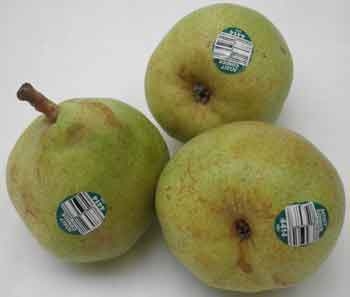Posts Tagged: Roberta Cook
California's delicious harvest season unfolds
Early spring can be an invigorating time of year, with lengthening days, blooming daffodils and fruit trees (and ski season still in full force). One of the best perks of the season is the availability of luscious strawberries, and tasty artichokes and asparagus picked from nearby farms, with flavor quality and price that reflects both in-season and local transportation benefits.
Depending on your location, farmers markets and pick-your-own farms will begin offering their wares within the next month or two. There are over 700 farmers markets in California. A wide variety of produce, from the exotic to the humble every-day variety, is available to entice you with its fresh beauty. We here in the West spend more annually on fresh produce at $511 vs. the national average of $429, wrote Roberta Cook, UC Cooperative Extension specialist in the UC Davis Department of Agriculture and Resource Economics, in “Eye on Economics: Much more than Dollars and Cents. Cook states that, “California produces half of the nation’s fresh fruits and vegetables and consumers here are privileged to have an abundance of high quality fresh produce over extended seasons due to California’s Mediterranean climate.”
Elsewhere in the United States “local” food markets are much less developed due to climate restrictions that limit production to a brief period in the summer and early fall; and the variety of products grown is only a fraction of the over 200 crops grown in California. While “local” production represents a rapidly growing share of U.S. agricultural sales, with direct-to-consumer sales more than quadrupling in the past decade, outside of California the share is still tiny.
There are few things as disappointing as biting into a piece of fruit that looks beautiful on the outside but just doesn’t deliver that burst of flavor, or cutting into a nice-looking vegetable only to find an unsightly defect inside. When I’m prowling through a display of fresh produce, I rev up all my senses into high gear and get up-close and personal with the fruit and veggie items on my list. I get busy feeling the weight-to-size ratio, gently (not too hard, mind you, or you’ll get a bad reputation with other shoppers) pressing to feel for firmness, looking at color, form, and stem separation area, and smelling the aroma. All of these things, and more, help provide clues about the quality inside.
Country of Origin Labeling (COOL) and Price Look Up (PLU) stickers
Other clues are often available about where and how your produce items were grown. For instance, in 2009 rules (affecting retail grocers) were adopted by the USDA mandating country of origin labeling (COOL), which required that retailers notify customers of the country of origin of all perishable agricultural commodities. Also offering insights into your produce selection is the Price Look Up sticker. Created by the Produce Marketing Association (PMA) in 1987 to create a standardized system to assist check-out clerks with looking up the produce items, it also indicates additional information such as whether it’s organic.
For instance, if your produce item’s sticker has a 4 digit code, it is “conventionally grown, but not organic.” If the code has 5 digits, and the first digit is a 9, the produce was organically grown. Usually the PLU stickers also include the country of origin in writing, but if not, this information should be displayed on the packing box or other store signage. Conventionally grown produce is recognized by scientists and regulators to be just as safe as organically grown and there is no evidence that it is worse for the environment. About 95 percent of retail fresh produce sales are conventionally grown and generally cost about 30 percent less than organics.
There are a number of resources that can help produce shoppers improve their savvy shopping skills:
From the Farm to Your Table: A Consumer’s Guide to Fresh Fruits and Vegetables, by James Thompson and Adel Kader. This 16-page booklet offers information on measuring quality; farm-based growing conditions, practices and harvesting; handling, transportation and storage; and selecting and storing good-quality produce for use at home. The table on how to select good-quality produce is especially helpful. ($7.00/copy)
Shopping for Fruits & Vegetables at the Fruits and Veggies: More Matters web site
Storing Fresh Fruit and Vegetables for Better Taste, a free downloadable poster from the UC Davis Postharvest Technology Center
i know produce, a comprehensive produce website developed by the Produce Marketing Association (PMA) that includes photo identification, written description, availability by location, nutrition information, storage/handling, and tips.
The more you know, the more careful you are
With a daughter soon to complete a degree in health safety, discussions of Salmonella, E. coli and the like sometimes arise as we sit around the dinner table. As an agriculturally focused family, we like to think we’re pretty savvy about the best way to handle our produce to keep it safe and tasty.
Some are very concerned about food safety. A gentleman phoned the Postharvest Technology Center a few months ago, and shared that he was very concerned about eating strawberries. He thought perhaps he should scrub each one with a soft toothbrush, and then soak them in a diluted chlorine bath.
Others are much less aware of food safety concerns, sometimes using cutting boards and knives interchangeably between raw meat and produce items, or other unsafe food handling practices.
Dr. Roberta Cook, a marketing and postharvest specialist affiliated with the center reported, “in 2008, 53 percent of shoppers interviewed in a national survey by the Food Marketing Institute, named ‘bacteria or germs’ as a serious health risk to their food, ranking it as their number one concern.” The produce industry and the U.S. Food and Drug Administration continue to work hard to establish safe procedures for every step between the farm and the market.
Dr. Linda Harris, a food safety specialist, and Dr. Christine Bruhn, a consumer food marketing dpecialist, also affiliated with the Postharvest Technology Center, offer the following concise steps for the safe handling of produce:
- In the grocery cart and at home, keep fruits and vegetables separated from raw meat, poultry, and seafood to prevent cross-contamination.
- Once at home, store all fresh-cut ready-to-eat prepared produce in the refrigerator to keep it cold.
- Wash all whole fruits and vegetables, including larger items like melons, just before preparation for eating. Cut out damaged (bruised, discolored) areas before eating.
- Before and after handling fruits and vegetables, make sure that your work area and utensils are clean and that your hands have been washed with hot soapy water.
- Fruits and vegetables should be washed under running water. Soaking them in water increases the opportunity for cross-contamination and is not recommended.
- Produce such as apples, cucumbers and melons that can be rubbed without damage should be scrubbed using clean hands or a clean scrub brush.
- Dry washed fruits and vegetables with clean disposable paper towels.
- It is not necessary to wash ready-to-eat prewashed and packaged fresh-cut produce. If you choose to rewash this type of produce, follow the instructions above. Always wash unpackaged prepared salad mixes under running water prior to consumption.
- Once cut or prepared, all fruits and vegetables should be refrigerated promptly. After serving, refrigerate leftovers within 2 hours.
Additional produce safety resources:
"How to Properly Wash your Produce" video by Dr. Christine Bruhn.
For more University of California information about the safe handling of fruits and vegetables:
UC Home Gardening, Preservation and Storage Publications
Safe Handling of Fruits and Vegetables (pdf)
Food safety brochure (pdf)
Keep your fruits and veggies tasting better longer
As you returned home from the market and unloaded your sack of produce, have you ever simply admired the satisfying bounty? Enjoyed the color, texture, and aroma as cantaloupe, broccoli, carrots, tomatoes, lettuce, cherries, apricots, avocado, strawberries and more passed through your hands? But now, what to do with each item … how best to keep it fresh and tasty until you’re ready to eat it?
The Postharvest Technology Center offers free copies of an 8.5” x 11” full color poster that shows which produce items should go in your refrigerator, which items should never go in the refrigerator, and finally, which items should be ripened at room temperature and then placed in the refrigerator.
“’Storing Fresh Fruits and Vegetable for Better Taste’ is a handy tool to keep on your refrigerator,” said Beth Mitcham, center director. “Where you store your produce can have a profound effect both on how good it tastes, and how long you can keep it at an optimal state until you’re ready to serve it to your family.”
Produce marketing researchers have noted that with the current recession, shoppers are feeling guiltier than ever when they end up having to toss out fruits or veggies ‘gone bad.’
“It’s like a double guilt,” explained Dr. Roberta Cook, “not only has the shopper with the best of intentions not eaten the food they know is healthiest for them, but they have also wasted their money. Following the handling recommendations for each produce item can really improve the consumer’s experience on several levels.”






